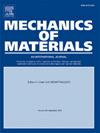316L奥氏体钢板和钢管的结晶塑性建模:多轴变形和温度对应变诱导马氏体相变程度的影响
IF 4.1
3区 材料科学
Q2 MATERIALS SCIENCE, MULTIDISCIPLINARY
引用次数: 0
摘要
采用基于应力状态的马氏体相变模型和基于位错密度演变的硬化规律的弹塑性自一致结晶塑性模型来模拟和解释316l不锈钢的变形行为。模型中组成晶粒的变形是由晶体滑移和相变引起的各向异性弹性和塑性的结合。在几种应变速率和温度下对钢进行了简单拉伸试验,以记录模型参数识别的数据。将校正后的EPSC模型作为隐式有限元(隐式有限元)的本构律,用于求解微管的膨胀/张力和板的双轴张力等边值问题。这些多级模拟验证了FE-EPSC模型能够捕获316l管和板的应变路径敏感变形。利用电子背散射衍射(EBSD)和中子衍射测量了α′-马氏体体积分数和织构演变的程度,并利用数字图像相关(DIC)技术测量了应变场,以进行多级模型验证。预测的几何、力学场、相和织构的演变与实验测量结果吻合较好。该模型成功地预测了在双轴拉伸下比单轴拉伸下形成更多的马氏体,与实验测量结果一致。预测结果与实验测量结果的良好比较使我们能够合理地解释316l钢变形马氏体相变趋势的起源。虽然单轴加载有利于马氏体转变,但双轴加载在晶粒中引起应力场,导致部分位错之间的大分离,使双轴加载的马氏体转变程度大于单轴加载。本文章由计算机程序翻译,如有差异,请以英文原文为准。
Crystal plasticity modeling of 316L austenitic steel sheets and tubes: Role of multiaxial deformation and temperature on the extent of strain-induced martensitic transformations
An elasto-plastic self-consistent crystal plasticity model integrating a stress state-dependent martensitic transformations model and a hardening law based on the evolution of dislocation densities was used to model and interpret the deformation behavior of 316 L stainless steel. The deformation of constituent grains in the model involved a combination of anisotropic elasticity and plasticity via crystallographic slip and phase transformations. The steel was tested in simple tension under several strain-rates and temperatures to record the data for the identification of model parameters. The calibrated and validated EPSC model was then used as a constitutive law in implicit finite elements (FE) for solving several boundary value problems including inflation/tension of microtubes and biaxial tension of sheets. These multi-level simulations enabled the verification of the FE-EPSC model to capture the strain-path sensitive deformation of the 316 L tubes and sheets. The extent of -martensite volume fraction and texture evolution were measured using electron-backscattered diffraction (EBSD) and neutron diffraction, while the strain fields were measured using digital image correlation (DIC) technique for the multi-level model verification. The evolution of geometry, mechanical fields, phases, and texture were predicted to agree well with the experimental measurements. The model successfully predicted more martensite formation under biaxial tension than uniaxial tension, consistent with the experimental measurements. Favorable comparisons of the predictions and experimental measurements allowed us to rationalize the origins of the martensitic transformation trends with deformation in 316 L steel. Although the uniaxial loading evolved crystallography of the structure to favor the martensitic transformation, the biaxial loading induced stress fields in the grains to cause large separations between partial dislocation giving rise to a greater extent of the martensitic transformation in biaxial than uniaxial loading.
求助全文
通过发布文献求助,成功后即可免费获取论文全文。
去求助
来源期刊

Mechanics of Materials
工程技术-材料科学:综合
CiteScore
7.60
自引率
5.10%
发文量
243
审稿时长
46 days
期刊介绍:
Mechanics of Materials is a forum for original scientific research on the flow, fracture, and general constitutive behavior of geophysical, geotechnical and technological materials, with balanced coverage of advanced technological and natural materials, with balanced coverage of theoretical, experimental, and field investigations. Of special concern are macroscopic predictions based on microscopic models, identification of microscopic structures from limited overall macroscopic data, experimental and field results that lead to fundamental understanding of the behavior of materials, and coordinated experimental and analytical investigations that culminate in theories with predictive quality.
 求助内容:
求助内容: 应助结果提醒方式:
应助结果提醒方式:


